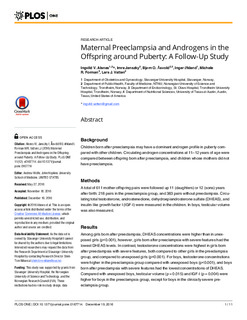| dc.contributor.author | Forman, Michele R. | |
| dc.contributor.author | Økland, Inger | |
| dc.contributor.author | Alsnes, Ingvild Vatten | |
| dc.contributor.author | Åsvold, Bjørn Olav | |
| dc.contributor.author | Janszky, Imre | |
| dc.contributor.author | Vatten, Lars Johan | |
| dc.date.accessioned | 2017-03-17T12:13:02Z | |
| dc.date.available | 2017-03-17T12:13:02Z | |
| dc.date.created | 2016-12-21T12:11:21Z | |
| dc.date.issued | 2016 | |
| dc.identifier.issn | 1932-6203 | |
| dc.identifier.uri | http://hdl.handle.net/11250/2434530 | |
| dc.description.abstract | Background
Children born after preeclampsia may have a dominant androgen profile in puberty compared with other children. Circulating androgen concentrations at 11–12 years of age were compared between offspring born after preeclampsia, and children whose mothers did not have preeclampsia.
Methods
A total of 611 mother-offspring pairs were followed up 11 (daughters) or 12 (sons) years after birth: 218 pairs in the preeclampsia group, and 383 pairs without preeclampsia. Circulating total testosterone, androstenedione, dehydroepiandrosterone sulfate (DHEAS), and insulin-like growth factor I (IGF-I) were measured in the children. In boys, testicular volume was also measured.
Results
Among girls born after preeclampsia, DHEAS concentrations were higher than in unexposed girls (p<0.001), however, girls born after preeclampsia with severe features had the lowest DHEAS levels. In contrast, testosterone concentrations were highest in girls born after preeclampsia with severe features, both compared to other girls in the preeclampsia group, and compared to unexposed girls (p<0.001). For boys, testosterone concentrations were higher in the preeclampsia group compared with unexposed boys (p<0.001), and boys born after preeclampsia with severe features had the lowest concentrations of DHEAS. Compared with unexposed boys, testicular volume (p = 0.015) and IGF-I (p = 0.004) were higher for boys in the preeclampsia group, except for boys in the clinically severe preeclampsia group.
Conclusions
In utero exposure to preeclampsia is associated with androgen hormonal patterns in early puberty that depend on clinical severity of preeclampsia and sex of the offspring. The hormonal differences may reflect different timing of pubertal development, and may have consequences for future health of the offspring. | nb_NO |
| dc.language.iso | eng | nb_NO |
| dc.publisher | Public Library of Science | nb_NO |
| dc.rights | Navngivelse 4.0 Internasjonal | * |
| dc.rights.uri | http://creativecommons.org/licenses/by/4.0/deed.no | * |
| dc.title | Maternal Preeclampsia and Androgens in the Offspring around Puberty: A Follow-Up Study | nb_NO |
| dc.type | Journal article | nb_NO |
| dc.type | Peer reviewed | nb_NO |
| dc.source.journal | PLoS ONE | nb_NO |
| dc.identifier.doi | http://dx.doi.org/10.1371/journal.pone.0167714 | |
| dc.identifier.cristin | 1416103 | |
| dc.description.localcode | © 2016 Alsnes et al. This is an open access article distributed under the terms of the Creative Commons Attribution License, which permits unrestricted use, distribution, and reproduction in any medium, provided the original author and source are credited. | nb_NO |
| cristin.unitcode | 194,65,20,15 | |
| cristin.unitcode | 194,65,20,0 | |
| cristin.unitname | Institutt for samfunnsmedisin | |
| cristin.unitname | Helseundersøkelsen i Nord-Trøndelag | |
| cristin.ispublished | true | |
| cristin.fulltext | original | |
| cristin.qualitycode | 1 | |

